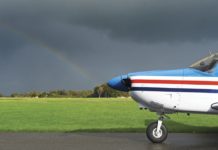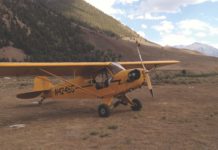As an active instrument instructor, I frequently see confusion in my customers about making the transition from an approach to the missed-approach procedure using a GPS. Even many pilots with a great deal of instrument time don’t demonstrate mastery of a GPS navigator’s “suspend” mode, or know how vital its proper use is to safely executing a missed approach.
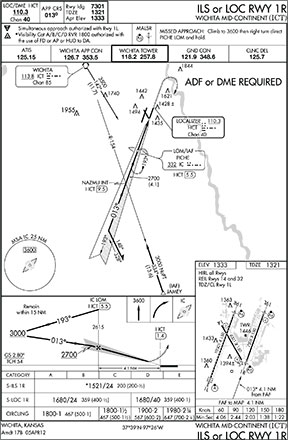
Basically, a GPS navigator in normal operation always is navigating to the next fix. But when it arrives at a missed approach point, it doesn’t know what to do: sequence to the destination airport, to the holding fix or do something else? So, it goes into suspend mode. Of course, there’s more to it than that, so let’s review how the GPS suspend function protects you, and how you must use it to assure a safe “missed.”
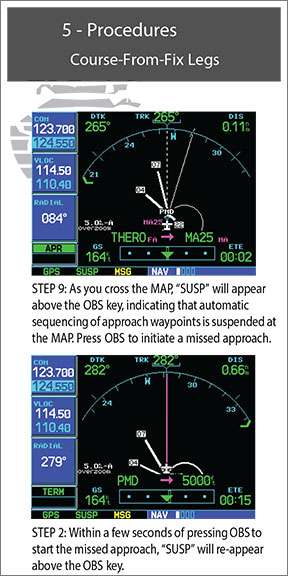
Missed Approach Point
Whether you’re flying an RNAV/GPS approach or using an IFR approach-certified GPS to supplement ground-based approach navigation such as an ILS, chances are you’ll use it for guidance when you need to fly a missed approach procedure. Assuming you’ve set it up properly, your GPS will track and guide your progress down the final approach course to the missed approach point (MAP). When you pass the MAP, the GPS will automatically suspend operation and indicate as such. Why?
Every missed approach procedure contains two elements: climb to a safe altitude, and do so in a safe direction. Often, because of obstacles, terrain or conflicts with other IFR procedures or routes, a missed approach procedure will require you to climb straight ahead or on a specific heading, localizer or VOR radial until reaching an altitude from which it is safe to turn toward a holding fix.
The problem is GPS devices have no way of predicting how far across the ground you’ll travel before you reach this safe “turn altitude.” You might be flying a Beechcraft Baron, or a Gulfstream IV or a Cessna 150. You might climb aggressively or at a shallower deck angle than the next pilot. Your airplane might be heavily loaded or light; the density altitude may be high or low. In a multi-engine airplane, you might even be flying the missed on one engine. And ATC may issue alternate missed approach instructions, for a variety of reasons.
Therefore, the GPS can’t paint a magenta line on the moving map that indicates where you’ll be able to safely make a turn.
The latest software iterations of the Garmin G1000 and G2000 integrated flight decks watch out for you more than other GPS units. They still can’t plot the ground track for a missed approach ahead of time, however, for the same reasons we’ve already noted (airplane type, airplane weight, available power, pilot technique and environmental factors). Instead, they draw a dashed line from the MAP in the direction of the initial, pre-turn climbout. The instruction to the pilot: Climb straight ahead until reaching the altitude from which you may begin any required turn. These savvy flight decks then reference the IFR database, find the turn altitude, and, when the airplane reaches that height, automatically return to OBS mode and plot the ground track for the remainder of the missed approach.
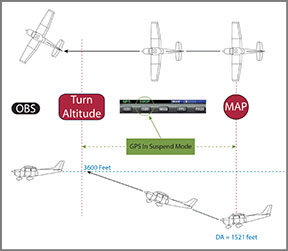
Virtually every other type of GPS, including the vast majority of IFR airplanes’ equipment (Garmin’s market-capturing GNS 430/530 series), will suspend displaying navigational guidance until you tell it you have reached the safe turning altitude. You do this by pushing the OBS button on Garmin equipment, or similarly exiting suspend mode on other makes of GPS, when you reach that minimum altitude.
Doing it
Let’s put this into context: Check out the approach plate for the ILS 1R procedure at Wichita’s Mid-Continent Airport on the opposite page. The published missed approach procedure is to “climb to 3600 then right turn direct” to the holding fix. Looking closely at the overhead view, you’ll see why: a tower topping at 1621 msl (100 feet above decision altitude) just northeast of the airport, and another tower with a top at 1844 (323 feet above DA) a mile or so beyond. The missed approach procedure for the parallel runway prevents a left-hand turn. To ensure sufficient clearance above both towers and to deconflict traffic on the approach/miss to Runway 1L, the 1R missed approach procedure calls for a straight-ahead climb to 3600 feet msl before making essentially a 180-deg. turn to the right, toward the missed-approach hold, the PICHE locator outer marker/fix.
When you cross the ILS 1R MAP and the GPS enters suspend mode, power up, pitch up, clean up (gear and flaps as applicable), open up (cowl flaps if so equipped) and ’fess up (report your missed approach). But fly the localizer without touching the GPS until you reach 3600 feet.
When you reach this safe “turn altitude,” push the OBS button to exit suspend mode. The GPS will now depict a route from your present position to the holding fix. Turn in the proper direction and fly the procedure.
The illustration in the sidebar on page 21 depicts the “GPS suspend phase” of the KICT ILS 1R missed approach procedure, the steps a pilot should take between initiating the missed approach and reaching the safe turning altitude.
What happens if you hit the OBS button before you reach the safe turning altitude? The GPS will plot a turn toward the holding fix from your present position. If you’re using a flight director in GPSS, navigation or approach mode, it will prompt you to begin the turn. If you’ve engaged your autopilot in GPSS, nav or approach mode, it will make the turn for you.
As soon as you exit suspend mode, the GPS assumes you are clear of obstacles and it’s safe to make this turn—and may take you right into the obstacle or airspace conflict. This is the error I see frequently during instrument proficiency checks and other IFR instruction: exiting the suspend mode too early. This either prompts the pilot to start a turn before it’s safe to do so, or provides confusing course guidance because the magenta line on the moving map—which also is feeding data to the HSI, flight director or autopilot—is not the route that you need to fly to safely arrive at the holding fix.
Missing before the MAP
Sometimes you may choose to begin flying the missed approach procedure before you reach the missed approach point. In some GPS approaches with vertical navigation, you’ll reach the decision altitude before you get to the runway threshold.
In either of these cases, the GPS will continue to display course guidance until you actually reach the MAP, then automatically switch to the suspend mode. Follow the course guidance to the MAP, even if you choose not to descend all the way to minimums (or to begin your climb early).
Once you cross the MAP, proceed in suspend mode until you reach a safe turning altitude—just as if you had flown the approach all the way to minimums.
Straight-ahead misses
Many missed approach procedures, especially in GPS stand-alone procedures, call for a climb straight ahead to a holding fix. The GPS will still enter suspend mode when you cross the MAP, but since there is no “turn altitude” you can immediately revert to GPS navigation as soon as you have entered your missed-approach climb.
Don’t be spring-loaded to automatically press the OBS button and exit suspend mode as soon as you begin a missed approach. The day may come when you fly a missed approach “for real” that requires you reach a safe altitude first, and only then make a turn.
Understanding Suspend Mode
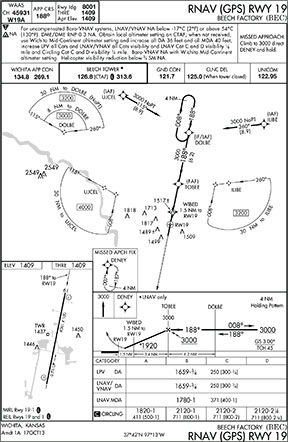
According to the FAA’s Advanced Avionics Handbook (FAA-H-8083-6), “Every IFR-capable FMS/RNAV unit offers an alternative mode of operation, the nonsequencing mode….” The nonsequencing mode differs from the sequencing mode in two important ways:
“1. Nonsequencing mode allows you to select a different inbound course to the active waypoint…. As the OBS knob allows you to select inbound VOR radials, the nonsequencing mode allows you to select inbound courses to an active waypoint.
“2. Nonsequencing mode stops the waypoint sequencing feature of the FMS/RNAV unit. If engaged in nonsequencing mode, the FMS/RNAV program does not automatically sequence to the next waypoint in the flight plan when the aircraft arrives at the active waypoint.”
In other words, suspend mode, as we’re discussing it in the context of missed approaches, is nothing more than the GPS navigator stopping its normal sequencing to the next waypoint. As the article’s main text explains, that’s because the GPS navigator doesn’t (and can’t) know what you’ll do next: land or start climbing for the missed approach holding point.
The Advanced Avionics Handbook again: “It is important to remember that the nonsequencing mode suspends the FMS/RNAV’s waypoint sequencing function. If you reach [a waypoint] and the unit is still set in the nonsequencing mode, it will not sequence on to the next waypoint. Generally, once established on a direct course to waypoint or navaid, switching back to sequencing (releasing the Hold or Suspend function) mode allows the FMS/RNAV to continue to the programmed point and thence onward according to the programmed routing.”
Briefing the Approach…Including the Missed

If I were asked to cite the single most common mistake I see experienced IFR pilots make during recurrent training, I’d probably have to say lack of preparation for the missed approach. This is indicative, in my view, of failing to prepare fully for the approach, even if don’t need to fly the missed.
Instead of thinking of an instrument approach procedure (IAP) as a single procedure from an initial approach fix (IAF) through the missed approach point (MAP) to the missed approach holding fix. Most of the time, the IAP is interrupted along the way by conditions that permit you to land the airplane. But to prepare to fly the IAP in the first place you must brief the entire procedure—including what you must do to fly the missed.
In my recent article “SIDuational Awareness” (June 2014), I described adapting the concept of Aresti diagrams—those cockpit hieroglyphics used by competitive aerobatics pilots—as an IAP briefing tool. In particular, I described a method of sketching out a standard instrument departure (SID) on a “sticky note,” pulling the pertinent data out of the chart and sticking it on the panel near my primary scan so I would not have to find it in all the fine print while actually flying a high-workload procedure.
I use the same technique to brief IAPs, including the missed approach. I include a very simple side view of the final altitude to the final approach fix (FAF), a depiction of the descent to the MAP, and a heading-up, overhead view of the missed approach procedure and hold.
Here’s an example: Say you’ll be flying the RNAV 19 approach into Wichita (Kansas) Beech Field, reproduced above, using the LNAV/VNAV minimums. It’s after hours, so you use the Wichita Mid-Continent Airport altimeter setting and increase the DA (Decision Altitude) by 36 feet, per the long note at the top of the chart. Since the published DA is 1659 feet msl, the LNAV/VNAV DA for your approach is now 1695 feet.
It’s noteworthy that you’ll reach the MAP before reaching the runway threshold while descending on the GPS-derived glidepath. In this instance, the GPS will not enter suspend mode until you fly past where the MAP is located when Beech Tower is open.
And where will you go as you missed this approach? The procedure calls for a climb, straight ahead, to 3000 MSL to hold at DENEY. Since this approach does not require you to climb to a turn altitude before proceeding with the procedure—put another way, you’re already above the safe turn altitude because there is no turn—you can push the OBS button and exit suspend mode as soon as workload permits.
What happens when you reach DENEY? The charted holding pattern calls for holding with an inbound course of 007 deg., in the opposite direction and pointed back toward the airport, with right-hand turns. The outbound course in the hold is 187 deg., which is of course your ground track as you fly from the MAP to DENEY. And how will you maneuver to enter the hold? It looks like a teardrop entry will work, turning to a heading of about 150 deg. after crossing DENEY outbound. Sure, most GPS navigators will prompt you with headings. But the day may come that you’re flying without a GPS, or you may have a unit that does not provide these prompts.
To fully brief and prepare for this approach, you can create an Aresti-like diagram on a sticky note that looks something like the one included above. This distills down all those convoluted notes and changes to the basic procedure (which result from after-hours operation) into only that information you need to fly the approach this time. It also includes the basics of the missed approach procedure.
The act of writing it out helps you burn the information into your short-term memory. And if you stick the note where you can see it as you fly the approach, you can find the critical information without having to try to find it in the small print of your approach chart or electronic flight bag (EFB) device. Everything you need to know from just outside the FAF all the way to the missed approach holding pattern is right there where you can see it.

